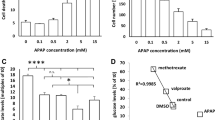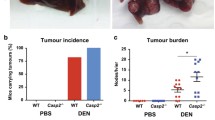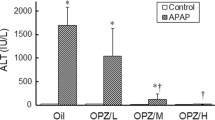Abstract
Mouse liver tumors that harbor activating mutations in Ctnnb1, encoding β-catenin, express high levels of various cytochromes P450 (CYP), including CYP2E1 and CYP1A2. Acetaminophen (AAP) is metabolized in hepatocytes by these CYPs to the reactive intermediate N-acetyl-p-benzoquinone-imine, which is toxic to hepatocytes at high doses where depletion of glutathione occurs. We have induced liver tumors in mice by treatment with the liver carcinogen N-nitrosodiethylamine followed by chronic treatment with the tumor promoter phenobarbital. Under this protocol, ~80 % of tumors display Ctnnb1 mutations and express high levels of various CYP isoforms. Tumor-bearing animals were given a single intraperitoneal injection of 300 mg/kg body weight AAP, which was well tolerated by the animals. This dose, however, eradicated essentially all larger Ctnnb1-mutated, CYP-positive liver tumors, killing >90 % of hepatoma cells: at 2 days after AAP, large necrotic areas filled with cell debris were observed in tumors. These were infiltrated in the following days by immune cells starting from the outer parts of the damaged areas slowly closing the “wounds” left from the poisoned tumor cells. During this period, there was increased proliferation of normal hepatocytes, but some residual tumor cells were also proliferating. Our results show that a selective poisoning of Ctnnb1-mutated liver tumors by administration of AAP is possible in this experimental system. Application of an adapted protocol could be envisaged for neo-adjuvant treatment of human hepatoblastoma which are frequently mutated in CTNNB1 and often show high expression of CYP2E1.






Similar content being viewed by others
Abbreviations
- CYP:
-
Cytochrome P450
- AAP:
-
Acetaminophen
- HB:
-
Hepatoblastoma
- PB:
-
Phenobarbital
- GS:
-
Glutamine synthetase
- MAPK:
-
Mitogen-activated protein kinase
- NAPQI:
-
N-Acetyl-p-benzoquinone-imine
- GSH:
-
Glutathione
- BrdU:
-
5-Bromodeoxyuridine
- MRI:
-
Magnetic resonance imaging
- G6Pase:
-
Glucose-6-phosphatase
- HE:
-
Hematoxylin/eosin
- HNF4α:
-
Hepatocyte nuclear factor 4α
References
Adams ML, Pierce RH, Vail ME, White CC, Tonge RP, Kavanagh TJ, Fausto N, Nelson SD, Bruschi SA (2001) Enhanced acetaminophen hepatotoxicity in transgenic mice overexpressing BCL-2. Mol Pharmacol 60:907–915
American Academy of Pediatrics, Committee on Drugs (2001) Acetaminophen toxicity in children. Pediatrics 108:1020–1024
Anderson BJ, Holford NH, Armishaw JC, Aicken R (1999) Predicting concentrations in children presenting with acetaminophen overdose. J Pediatr 135:290–295
Aydinlik H, Nguyen TD, Moennikes O, Buchmann A, Schwarz M (2001) Selective pressure during tumor promotion by phenobarbital leads to clonal outgrowth of beta-catenin-mutated mouse liver tumors. Oncogene 20:7812–7816
Benhamouche S, Decaens T, Godard C, Chambrey R, Rickman DS, Moinard C, Vasseur-Cognet M, Kuo CJ, Kahn A, Perret C, Colnot S (2006) Apc tumor suppressor gene is the “zonation-keeper” of mouse liver. Dev Cell 10:759–770
Braeuning A, Singh Y, Rignall B, Buchmann A, Hammad S, Othman A, von Recklinghausen I, Godoy P, Hoehme S, Drasdo D, Hengstler JG, Schwarz M (2010) Phenotype and growth behavior of residual beta-catenin-positive hepatocytes in livers of beta-catenin-deficient mice. Histochem Cell Biol 134:469–481
Cadoret A, Ovejero C, Terris B, Souil E, Levy L, Lamers WH, Kitajewski J, Kahn A, Perret C (2002) New targets of beta-catenin signaling in the liver are involved in the glutamine metabolism. Oncogene 21:8293–8301
Chafey P, Finzi L, Boisgard R, Cauzac M, Clary G, Broussard C, Pegorier J, Guillonneau F, Mayeux P, Camoin L, Tavitian B, Colnot S, Perret C (2009) Proteomic analysis of beta-catenin activation in mouse liver by DIGE analysis identifies glucose metabolism as a new target of the Wnt pathway. Proteomics 9:3889–3900
Cummings AJ, King ML, Martin BK (1967) A kinetic study of drug elimination: the excretion of paracetamol and its metabolites in man. Br J Pharmacol Chemother 29:150–157
Dahlin DC, Miwa GT, Lu AY, Nelson SD (1984) N-acetyl-p-benzoquinone imine: a cytochrome P-450-mediated oxidation product of acetaminophen. Proc Natl Acad Sci USA 81:1327–1331
de La Coste A, Romagnolo B, Billuart P, Renard CA, Buendia MA, Soubrane O, Fabre M, Chelly J, Beldjord C, Kahn A, Perret C (1998) Somatic mutations of the beta-catenin gene are frequent in mouse and human hepatocellular carcinomas. Proc Natl Acad Sci USA 95:8847–8851
Dixon MF, Nimmo J, Prescott LF (1971) Experimental paracetamol-induced hepatic necrosis: a histopathological study. J Pathol 103:225–229
Douglass EC, Green AA, Wrenn E, Champion J, Shipp M, Pratt CB (1985) Effective cisplatin (DDP) based chemotherapy in the treatment of hepatoblastoma. Med Pediatr Oncol 13:187–190
Gebhardt R (1992) Metabolic zonation of the liver: regulation and implications for liver function. Pharmacol Ther 53:275–354
Giera S, Braeuning A, Kohle C, Bursch W, Metzger U, Buchmann A, Schwarz M (2010) Wnt/beta-catenin signaling activates and determines hepatic zonal expression of glutathione S-transferases in mouse liver. Toxicol Sci 115:22–33
Gujral JS, Knight TR, Farhood A, Bajt ML, Jaeschke H (2002) Mode of cell death after acetaminophen overdose in mice: apoptosis or oncotic necrosis? Toxicol Sci 67:322–328
Hailfinger S, Jaworski M, Braeuning A, Buchmann A, Schwarz M (2006) Zonal gene expression in murine liver: lessons from tumors. Hepatology 43:407–414
Hamilton TC, Winker MA, Louie KG, Batist G, Behrens BC, Tsuruo T, Grotzinger KR, McKoy WM, Young RC, Ozols RF (1985) Augmentation of Adriamycin, melphalan, and cisplatin cytotoxicity in drug-resistant and -sensitive human ovarian carcinoma cell lines by buthionine sulfoximine mediated glutathione depletion. Biochem Pharmacol 34:2583–2586
Ho JC, Cheung ST, Leung KL, Ng IO, Fan ST (2004) Decreased expression of cytochrome P450 2E1 is associated with poor prognosis of hepatocellular carcinoma. Int J Cancer 111:494–500
Jackson CH, MacDonald NC, Cornett JW (1984) Acetaminophen: a practical pharmacologic overview. Can Med Assoc J 131:25–32
Jungermann K, Katz N (1989) Functional specialization of different hepatocyte populations. Physiol Rev 69:708–764
Kleiber M (1975) Metabolic turnover rate: a physiological meaning of the metabolic rate per unit body weight. J Theor Biol 53:199–204
Koch A, Denkhaus D, Albrecht S, Leuschner I, von Schweinitz D, Pietsch T (1999) Childhood hepatoblastomas frequently carry a mutated degradation targeting box of the beta-catenin gene. Cancer Res 59:269–273
Krutovskikh VA, Piccoli C, Yamasaki H (2002) Gap junction intercellular communication propagates cell death in cancerous cells. Oncogene 21:1989–1999
Loeppen S, Schneider D, Gaunitz F, Gebhardt R, Kurek R, Buchmann A, Schwarz M (2002) Overexpression of glutamine synthetase is associated with beta-catenin-mutations in mouse liver tumors during promotion of hepatocarcinogenesis by phenobarbital. Cancer Res 62:5685–5688
Loeppen S, Koehle C, Buchmann A, Schwarz M (2005) A beta-catenin-dependent pathway regulates expression of cytochrome P450 isoforms in mouse liver tumors. Carcinogenesis 26:239–248
Lopez-Terrada D, Gunaratne PH, Adesina AM, Pulliam J, Hoang DM, Nguyen Y, Mistretta T, Margolin J, Finegold MJ (2009) Histologic subtypes of hepatoblastoma are characterized by differential canonical Wnt and Notch pathway activation in DLK + precursors. Hum Pathol 40:783–794
Lustig B, Behrens J (2003) The Wnt signaling pathway and its role in tumor development. J Cancer Res Clin Oncol 129:199–221
Man XB, Tang L, Qiu XH, Yang LQ, Cao HF, Wu MC, Wang HY (2004) Expression of cytochrome P4502E1 gene in hepatocellular carcinoma. World J Gastroenterol 10:1565–1568
Meijer C, Mulder NH, Hospers GA, Uges DR, de Vries EG (1990) The role of glutathione in resistance to cisplatin in a human small cell lung cancer cell line. Br J Cancer 62:72–77
Miner DJ, Kissinger PT (1979) Evidence for the involvement of N-acetyl-p- quinoneimine in acetaminophen metabolism. Biochem Pharmacol 28:3285–3290
Mitchell JR, Jollow DJ, Potter WZ, Davis DC, Gillette JR, Brodie BB (1973a) Acetaminophen-induced hepatic necrosis. I. Role of drug metabolism. J Pharmacol Exp Ther 187:185–194
Mitchell JR, Jollow DJ, Potter WZ, Gillette JR, Brodie BB (1973b) Acetaminophen-induced hepatic necrosis. IV. Protective role of glutathione. J Pharmacol Exp Ther 187:211–217
Miyoshi Y, Iwao K, Nagasawa Y, Aihara T, Sasaki Y, Imaoka S, Murata M, Shimano T, Nakamura Y (1998) Activation of the beta-catenin gene in primary hepatocellular carcinomas by somatic alterations involving exon 3. Cancer Res 58:2524–2527
Moennikes O, Buchmann A, Romualdi A, Ott T, Werringloer J, Willecke K, Schwarz M (2000) Lack of phenobarbital-mediated promotion of hepatocarcinogenesis in connexin32-null mice. Cancer Res 60:5087–5091
Neuwelt AJ, Wu YJ, Knap N, Losin M, Neuwelt EA, Pagel MA, Warmann S, Fuchs J, Czauderna P, Wozniak M (2009) Using acetaminophen’s toxicity mechanism to enhance cisplatin efficacy in hepatocarcinoma and hepatoblastoma cell lines. Neoplasia 11:1003–1011
Okabe H, Satoh S, Kato T, Kitahara O, Yanagawa R, Yamaoka Y, Tsunoda T, Furukawa Y, Nakamura Y (2001) Genome-wide analysis of gene expression in human hepatocellular carcinomas using cDNA microarray: identification of genes involved in viral carcinogenesis and tumor progression. Cancer Res 61:2129–2137
Potter WZ, Davis DC, Mitchell JR, Jollow DJ, Gillette JR, Brodie BB (1973) Acetaminophen-induced hepatic necrosis. III. Cytochrome P-450-mediated covalent binding in vitro. J Pharmacol Exp Ther 187:203–210
Pritchard J, Brown J, Shafford E, Perilongo G, Brock P, Dicks-Mireaux C, Keeling J, Phillips A, Vos A, Plaschkes J (2000) Cisplatin, doxorubicin, and delayed surgery for childhood hepatoblastoma: a successful approach–results of the first prospective study of the International Society of Pediatric Oncology. J Clin Oncol 18:3819–3828
Rasmussen A, Kvist N, Kirkegaard P, Rechnitzer C (2008) Surgical treatment of children with hepatic tumours. Ugeskr Laeger 170:1366–1369
Raucy JL, Lasker JM, Lieber CS, Black M (1989) Acetaminophen activation by human liver cytochromes P450IIE1 and P450IA2. Arch Biochem Biophys 271:270–283
Reynolds M, Douglass EC, Finegold M, Cantor A, Glicksman A (1992) Chemotherapy can convert unresectable hepatoblastoma. J Pediatr Surg 27:1080–1084
Schmid A, Rignall B, Pichler BJ, Schwarz M (2012) Quantitative analysis of the growth kinetics of chemically induced mouse liver tumors by magnetic resonance imaging. Toxicol Sci 126:52–59
Schmidt A, Braeuning A, Ruck P, Seitz G, Armeanu-Ebinger S, Fuchs J, Warmann SW, Schwarz M (2011) Differential expression of glutamine synthetase and cytochrome P450 isoforms in human hepatoblastoma. Toxicology 281:7–14
Sia JYS, Chan YC (2006) Case report: paracetamol poisoning in a 2-year-old child – from international overview to the role of the Hong Kong Poison Information Centre. Hong Kong J Emerg Med 13:225–231
Stahl S, Ittrich C, Marx-Stoelting P, Koehle C, Altug-Teber O, Riess O, Bonin M, Jobst J, Kaiser S, Buchmann A, Schwarz M (2005) Genotype-phenotype relationships in hepatocellular tumors from mice and man. Hepatology 42:353–361
Sutherland RM (1986) Importance of critical metabolites and cellular interactions in the biology of microregions of tumors. Cancer 58:1668–1680
Tenenbein M (2004) Acetaminophen: the 150 mg/kg myth. J Toxicol Clin Toxicol 42:145–148
Udawatte C, Ripps H (2005) The spread of apoptosis through gap-junctional channels in BHK cells transfected with Cx32. Apoptosis 10:1019–1029
Vaupel PW, Frinak S, Bicher HI (1981) Heterogeneous oxygen partial pressure and pH distribution in C3H mouse mammary adenocarcinoma. Cancer Res 41:2008–2013
von Schweinitz D, Byrd DJ, Hecker H, Weinel P, Bode U, Burger D, Erttmann R, Harms D, Mildenberger H (1997) Efficiency and toxicity of ifosfamide, cisplatin and doxorubicin in the treatment of childhood hepatoblastoma. Eur J Cancer 33:1243–1249
Wachstein M, Meisel E (1957) Histochemistry of hepatic phosphatases of a physiologic pH; with special reference to the demonstration of bile canaliculi. Am J Clin Pathol 27:13–23
Xu XR, Huang J, Xu ZG et al (2001) Insight into hepatocellular carcinogenesis at transcriptome level by comparing gene expression profiles of hepatocellular carcinoma with those of corresponding noncancerous liver. Proc Natl Acad Sci USA 98:15089–15094
Acknowledgments
This work was supported by the Deutsche Forschungsgemeinschaft (SFB773) and the Innovative Medicine Initiative Joint Undertaking (IMI JU) under grant agreement number 115001 (MARCAR project). We acknowledge the excellent technical assistance by Johanna Mahr and Elke Zabinsky. We also thank Dr. F. Iglauer (Tuebingen, Germany) for the help with serum transaminase analyses and Dr. C. R. Wolf (Dundee, UK) for the gift of CYP1A antiserum.
Conflict of interest
Nothing to disclose.
Author information
Authors and Affiliations
Corresponding author
Electronic supplementary material
Below is the link to the electronic supplementary material.
Rights and permissions
About this article
Cite this article
Singh, Y., Braeuning, A., Schmid, A. et al. Selective poisoning of Ctnnb1-mutated hepatoma cells in mouse liver tumors by a single application of acetaminophen. Arch Toxicol 87, 1595–1607 (2013). https://doi.org/10.1007/s00204-013-1030-8
Received:
Accepted:
Published:
Issue Date:
DOI: https://doi.org/10.1007/s00204-013-1030-8




